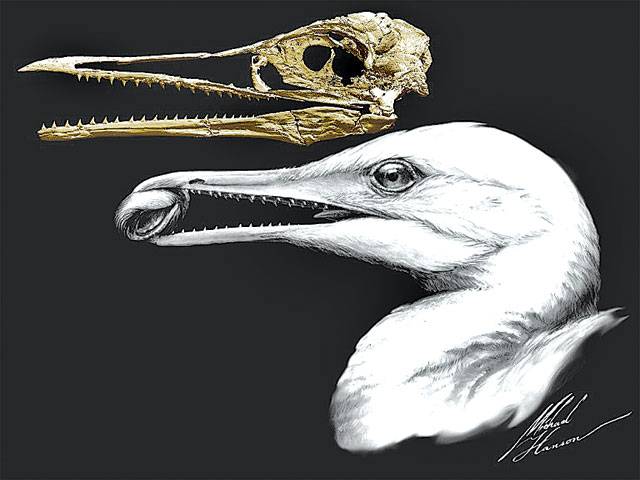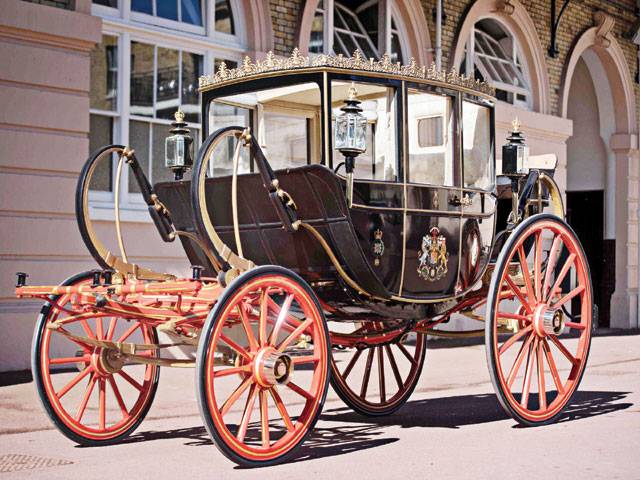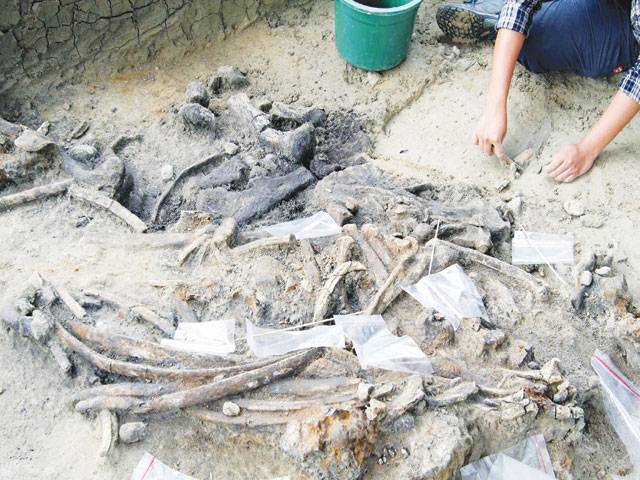Early bird had teeth: Study
PARIS (AFP): A gull lookalike with teeth: scientists refined their description Wednesday of a fascinating fowl at the evolutionary junction between dinosaur and modern bird - with skull features of both. Newly-discovered fossils show the extinct Icthyornis dispar, or "fish bird", had a mouth filled with sharp, curved teeth like those of a dinosaur, a team wrote in the scientific journal Nature. But the tip had been transformed into a sharp, toothless, "pincer-like" instrument - the original bird beak. This was likely used for preening and handling objects after reptile arms turned into wings. "Holding and perforation of prey probably fell to the sizeable, reptilian tooth row retained," in this dino-bird, the researchers added.
Palaeontologists say the first birds evolved from small, feathered dinosaurs possibly more than 100 million years ago.
Birds survived when the large lizards were wiped out some 65 million years ago at the end of the Cretaceous period during which I. dispar also lived.
The fish bird, thought to have been a surface-skimming or shallow-plunging feeder, had a larger-than-lizard brain similar to that of today's birds, said the researchers.
But some skull parts remained dinosaurian.
The newly-modelled skull, reconstructed from the fossil remains of several fish birds, lifted the veil on "what the bird beak looked like as it first appeared in nature," said study co-author Bhart-Anjan Bhullar, a Yale University palaeontologist.
"The first beak was a horn-covered pincer tip at the end of the jaw," he explained in a university press statement.
"The remainder of the jaw was filled with teeth. At its origin, the beak was a precision grasping mechanism that served as a surrogate hand."
The results showed that bird beaks started evolving earlier than thought, the team concluded.
The fish bird's so-called "transitional" beak was attached to a skull with an enlarged cavity for its evolving, more modern brain, the said.
But bones in the cheek region more dinosaur-like, with large chambers for stronger jaw-snapping muscles.
This indicated that in bird evolution, "the brain transformed first while the remainder of the skull remained more primitive and dinosaur-like," the researchers said.
I. dispar would have resembled a modern-day seabird - a gull or tern. With its mouth closed, the teeth would likely not have been visible.
Scientists first discovered Ichthyornis in the 1870s, but the first fossilised specimens were crushed and incomplete.
At the time, restoration and mounting of the fossils "were, shall we say, somewhat overenthusiastic," palaeontologist Kevin Padian of the University of California, Berkeley, wrote in a comment on the study.
Now remounted, previously overlooked elements from the early specimens have emerged. These, together with details from four newly-discovered and well-preserved fossils - three uncovered in museum collections - permitted the new 3-D reconstruction.
Based on early fossil finds, Ichthyornis was described with other "extinct toothed birds" in an 1880 publication by American palaeontologist Othniel Marsh.
Later that year, Charles Darwin thanked him for work that uncovered "the best support to the theory of evolution."
Prince Harry, Meghan pick carriage
for wedding procession
LONDON (AFP): Britain’s Prince Harry and Meghan Markle will ride in an open-top horse-drawn carriage through the streets of Windsor after their wedding later this month, Kensington Palace announced on Wednesday. The pair have chosen the Ascot Landau carriage for their procession through the town on May 19, their official London residence said in a statement. “Prince Harry and Ms. Markle are very much looking forward to this short journey which they hope will allow them to express their gratitude for everyone who has gathered together in Windsor to enjoy the atmosphere of this special day,” the statement said. The carriage will be drawn by four Windsor Grey horses - Milford Haven, Storm, Plymouth and Tyrone - and accompanied by a travelling escort of the Household Cavalry Mounted Regiment as it departs St George’s Chapel before touring a circuit of the town. The carriage is one of five Ascot Landaus in the palace collection, which are used by Queen Elizabeth II for her procession at the Royal Ascot horse race. Two featured in the 2011 wedding procession of Prince William and Catherine Middleton, also carrying best man Prince Harry, the maid of honour, bridesmaids and pageboys from Westminster Abbey to Buckingham Palace.
Early humans in Philippines
700,000 years ago
PARIS (AFP): Were the early humans roaming east Asia more than half-a-million years ago clever enough to build sea-faring watercraft and curious enough to cross a vast expanse of open sea?
This and other questions arise from the discovery in the Philippines of a butchered rhinoceros skeleton and the stone tools probably used to carve away its meat, researchers said Wednesday. The find pushes back the arrival of the first homo species on the island chain ten-fold to 700,000 years ago, they reported in the journal Nature.
Earlier archeological clues from Luzon island - tools at one site, pre-historic animals remains at another - hinted at the presence of primitive human species, echoing the way Homo erectus and Homo floresiensis probably populated the Indonesian archipelago during roughly the same period.
But until now, the earliest confirmed evidence of hominins - the scientific term used to group modern and early humans - in the Philippines came from a single, 67,000-year old foot bone unearthed in the Sierra Madre Mountains.
"We had the extraordinary luck to find a nearly complete, disarticulated rhinoceros," said Thomas Ingicco, a palaeoanthropologist at France's National Museum of Natural History and lead author of the study.
Analysis of the bones from the extinct species - Rhinoceros philippinensis - left no doubt "that it showed ridges left by tools," he told AFP.
Some of the cut marks were made while removing flesh, while others came from specialised tools designed to remove nourishing - and no doubt delicious - marrow.
Ingicco and his colleagues also uncovered the skeletal remains of other potentially tasty critters, including brown deer, monitor lizards, freshwater turtles and stegodons, extinct mammals combining elephant and mammoth features.
"We know that some species of human ate this rhino," said Ingicco. "But we don't know if they killed if first, or found the carcass."
All told, the Kalinga site in northern Luzon's Cagayan Valley yielded more than 400 bones and several dozen knapped - or chipped - tools, including 49 knife-like flakes and two hammers.
"This evidence pushes back the proven period of colonialization of the Philippines by hundreds of thousands of years," the authors concluded.
Several dating techniques applies to the rhino remains determined its age at between 631,000 and 777,000 years, putting it in a period known as the Pleistocene.
With no direct trace of the humans who butchered the animals, researchers could only speculate on who they were and how they got there.
Homo erectus - known to have wandered to present-day China and Southeast Asia up to million years ago - is one candidate.
It is also possible that the butchers of Kalinga had already evolved into a distinct sub-species, as likely happened to the "hobbit" of Flores, diminutive humans named for the Indonesian island where they were first found.
As for how "Kalinga Man" made it across what is today 1,000 kilometres (620 miles) of open ocean between Luzon and mainland Asia, the authors doubt they fashioned a raft or other sea-worthy vessel.
"The colonialization could have happened 'accidentally' after a tsunami ripped up the coastline and created a temporary land bridge, a rare but documented phenomenon," said Ingicco.








